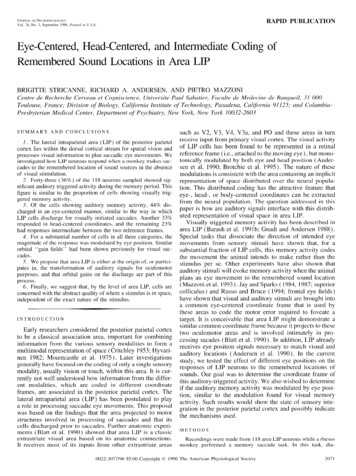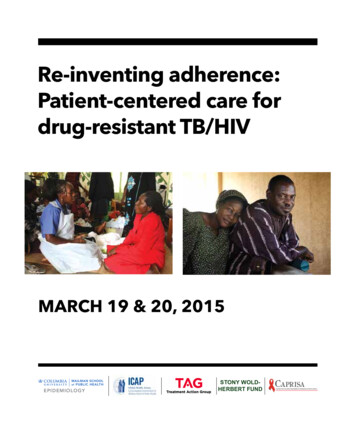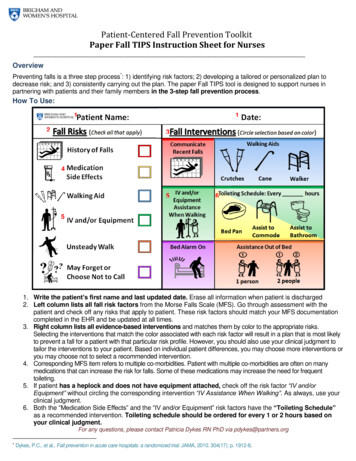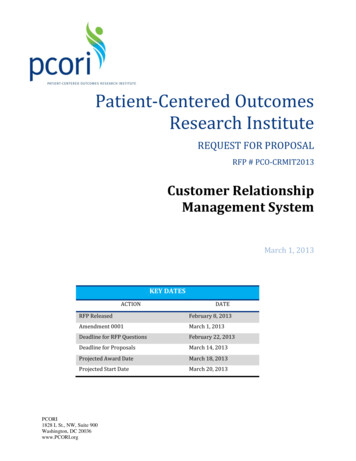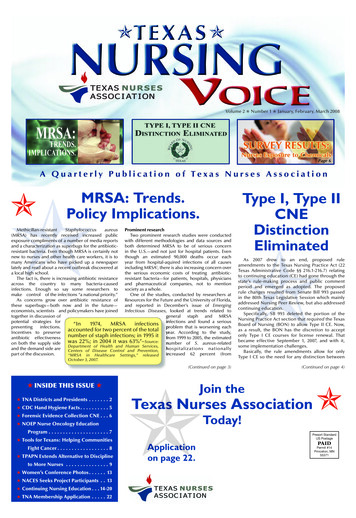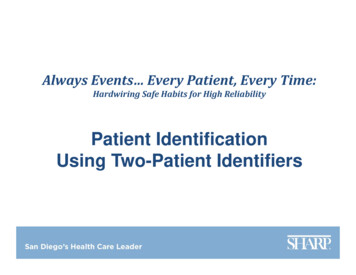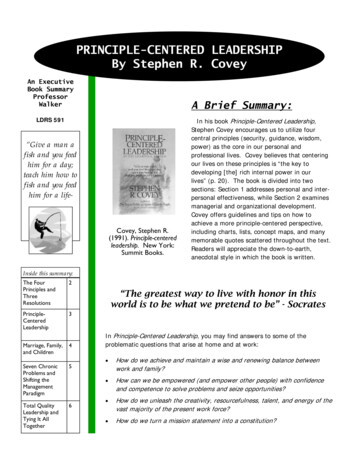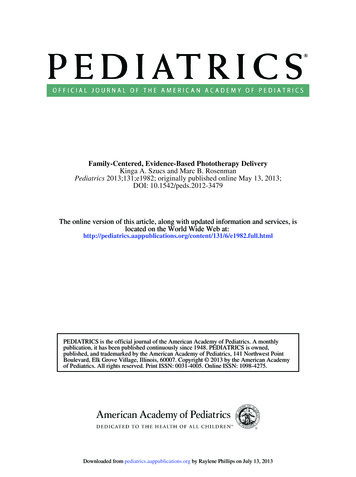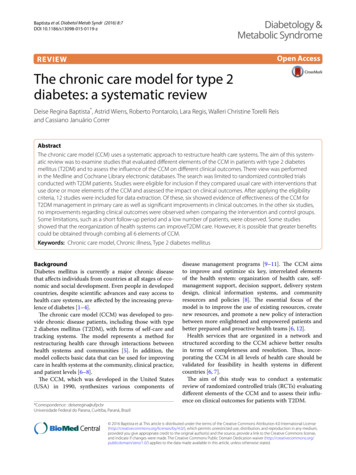
Transcription
Patient-Centered Care in Type 2Diabetes MellitusBy Amie D. Brooks, Pharm.D., FCCP, BCPS, BCACPReviewed by Krystal L. Edwards, Pharm.D., FCCP, BCPS; Rita Morelli, Pharm.D., BCACP; and S. Rochelle Sullivan, Pharm.D., BCACPLEARNING OBJECTIVES1. Apply components of patient-centered care to the management of patients with diabetes.2. Using patient-specific information, assess health literacy, psychological health, and patient activation in the managementof diabetes.3. Design individualized strategies for diabetes-related goal setting, education, and therapeutic management.4. Justify system-level strategies for enhancing patient-centered care of diabetes.5. Develop evidence-based, patient-specific glycemic and nonglycemic goals of therapy for patients with type 2 diabetes.INTRODUCTIONABBREVIATIONS IN THIS e have been many advancements in pharmacologic agentsfor the treatment of type 2 diabetes mellitus (T2DM) during thepast 3 decades. At the same time, evidence in support of interventional approaches, the relationship between clinical parameters andchronic complications, and effective self-management behaviorshas grown exponentially and has informed providers and patients ofeffective strategies for controlling blood glucose and other risk factors to minimize the risk of complications.Despite the growing armamentarium of treatment options andknowledge, many patients with diabetes do not meet evidence-basedgoals and continue to experience preventable complications. Thatdiscrepancy between optimal control and actual control can be attributed to multiple variables that include clinician, patient, and systemfactors. Central to all of them is the concept of patient-centered care.Successful diabetes care requires a patient’s consistent self-carebehaviors such as attention to diet, exercise, preventive care measures, drug adherence, and self-monitored blood glucose.In the area of chronic illnesses, diabetes exemplifies the directrelationship between patient behavior and clinical outcomes. Thestandard of care in T2DM includes emphasis on self-managementeducation provided through interprofessional teams. True implementation of patient-centered care in diabetes requires knowledge of thecomponents of that patient-centered care, as well as considerationof and attention to patient-specific factors that may influence outcomes. In addition, shared decision-making in daily clinical practicerequires the application and synthesis of contemporary evidencethat examines the goals of therapy in patients with diabetes.Atherosclerotic cardiovasculardiseaseChronic care modelCardiovascularCardiovascular diseaseDiastolic blood pressureDiabetes mellitusDiabetes self-managementeducationDiabetes self-managementsupportMyocardial infarctionPatient-centered medical homeSystolic blood pressureType 2 diabetes mellitusACSAP 2016 Book 1 Endocrinologic/Rheumatologic Care7Patient-Centered Care in Type 2 Diabetes Mellitus
Defining Patient-Centered Carebiopsychosocial perspective (consideration of whole person),(3) shared power and responsibility, and (4) patient-providerrelationship (therapeutic alliance) (Mead 2000).A provider’s efforts to understand the patient as a personand the way the patient experiences disease are crucial to apatient-centered approach. Because patients experience illness in individual ways, that personal narrative can motivatebehaviors or decisions that influence health. For example, thefinancial implications of a diagnosis or an individual therapymay motivate a patient to avoid seeking medical attention forsymptoms. Similarly, social or cultural norms may shape apatient’s perspective of an illness, a symptom, or a therapy,even if those norms are refuted by factual information from acredible health care professional.In addition to considering a patient as an experiencingindividual, the biopsychosocial perspective incorporates abroadened view of the patient-provider encounter to includeconsideration of nonmedical influences (e.g., social, psychological, health literacy, other factors) on illness, healthpromotion, and behavior modification. That perspective shiftsthe focus of health care from a primarily reactive approachaddressing acute and chronic illness to a more comprehensive and proactive approach that includes preventive healthcare (physical, social, psychological) and wellness. That biopsychosocial component of patient-centered care encourageshealth care professionals to consistently incorporate nonmedical influences into care plans rather than deem thoseinfluences beyond their practice scope.To further value a patient’s perspective and unique characteristics, patient-centered medicine promotes sharedresponsibility and power rather than a paternalistic approachin which the patient defers to medical authority. In otherwords, patient autonomy and participation are paramount.In contrast to that patient-centered approach, the providercentered approach creates a power dynamic that puts theprovider in control. In that situation, patient-provider encounters focus on the skills and knowledge of the clinician, withclosed questioning and directions given by the provider tothe patient and perhaps a caregiver. The illusion of control inthe provider-centered, paternalistic approach often shatterswhen the patient autonomously decides to not adhere to orimplement a therapy or a monitoring plan. A more effectiveapproach involves a shift from patient cooperation to mutualparticipation of the health care provider and the patient inshared decision-making.A natural extension of the first three components ofpatient-centered medicine is the patient-provider relationship.Historically, the concept of bedside manner has been regardedas a bonus rather than an integral element of effective healthcare. The patient-centered approach places high value on thetherapeutic alliance that a healthy patient-provider relationship can represent. At a minimum, the relationship shouldconsist of a provider who demonstrates empathy, effectivelistening, a shared understanding of health-related goals,Emphasized by the American Diabetes Association (ADA),the National Institute for Health and Care Excellence, and theInstitute of Medicine, a patient-centered approach to care hasincreasingly become both a parameter of quality assessmentand a widely acknowledged core value. In the setting of T2DM,patient-centered care is associated with increased patientsatisfaction, improved patient-provider communication, andenhanced patient well-being (IOM 2001; Kimmonth 1998).The concept of patient-centered care is generally understood, but its specific definition is not universally agreedupon. The literature describes conceptual models withcore concepts that are linked to positive outcomes such asincreased patient satisfaction, decreased symptom burden,increased efficiency of care, and decreased utilization (Little2001; Stewart 2000). Although the terminologies differ, commonly referenced key components include the concepts of(1) patient as person (disease and illness experience), (2)BASELINE KNOWLEDGE STATEMENTSReaders of this chapter are presumed to be familiarwith the following: National guideline recommendations for clinicalgoals (glycemia, blood pressure, lipids) in patientswith type 2 diabetes mellitus Potential chronic microvascular andmacrovascular complications of type 2 diabetes Oral and parenteral agents used in the treatment ofdiabetes, including their mechanisms of action,pharmacokinetics, dosing, adverse reactions,warnings and precautions, contraindications, anddrug interactionsADDITIONAL READINGSThe following resources are available for readers wishing additional background information on this topic. American Diabetes Association. Standards ofMedical Care in Diabetes—2015. A merican Diabetes Association/EuropeanAssociation for the Study of Diabetes PositionStatement. Management of Hyperglycemia in Type2 Diabetes, 2015: A Patient-Centered Approach. American Association of Clinical Endocrinologistsand American College of Endocrinology. ClinicalPractice Guidelines for Developing a DiabetesMellitus Comprehensive Care Plan—2015. American College of Cardiology/American HeartAssociation Task Force on Practice Guidelines.2013 American College of Cardiology/AmericanHeart Association Guideline on the Treatment ofBlood Cholesterol to Reduce AtheroscleroticCardiovascular Risk in Adults.ACSAP 2016 Book 1 Endocrinologic/Rheumatologic Care8Patient-Centered Care in Type 2 Diabetes Mellitus
Tang 2008; Powell 2007; Schilliner 2003). Assessment of healthliteracy may facilitate a more individualized, patient-centeredapproach to care in the setting of diabetes. Table 1-1 summarizes some commonly used, validated instruments to assesshealth literacy in clinical practice.Numeracy is an essential component of health literacy inthe setting of diabetes. Several health literacy instrumentsinclude an evaluation of numeracy (see Table 1-1). Diabetesself-care includes routine review and interpretation of numerical information such as self-monitored blood glucose, foodquantification from food labels, and drug dosages—especiallyin the case of insulin. As may be expected, numeracy ismore strongly correlated with glycemic control than is general health literacy (Osborn 2009; Cavanaugh 2008). Whenassessing health literacy for the purposes of patient-centeredcare in diabetes, the clinician should ideally use a validatedtool that has a numeracy component.and mutual trust. Emphasis on those four key componentsensures that care is individualized, respectful, and responsiveto patient preferences, needs, and values. It is an approachthat places the patient at the center of care as the final driverof therapy and other health care decisions.The Centrality of the PatientScience is the fundamental basis of clinical practice, andhealth care professionals spend years working with textbooks and laboratory experiments before interacting withpatients. Therefore, the incorporation of evidence-basedprinciples into practice is a relatively easy transition formost providers. However, effective implementation of thepatient-centered approach requires a broader skill set thatdraws on such areas as communication, professionalism,and empathy. Incorporation of these principles will requirean understanding of the evidence that supports a meaningfulrelationship between clinical outcomes and patient-specificcharacteristics such as health-literacy, depression, andpatient activation.Self-Efficacy and Patient ActivationSelf-efficacy is a patient’s confidence in the ability to performa goal-directed behavior. In patients with diabetes, a correlation between self-efficacy, self-care behaviors and glycemiccontrol has been demonstrated (Wallston 2007). A similarconcept—patient activation—incorporates not only a level ofconfidence but also the patient’s knowledge and skill level asit involves health care. Patients with high levels of activationare more likely to obtain preventive care and practice positiveself-care behaviors (Mosen 2007).Self-management education is consistently recommendedfor patients with diabetes, but the method and manner in whicheducation is provided are also important. The mere sharing of knowledge does not translate to improved outcomes.A tailored approach to self-management education and anassessment of patient activation are preferred. Fortunately,patient activation is developmental, and positive changeshave been associated with improved outcomes. The PatientActivation Measure (PAM) 13 is a validated tool that assessesdegree of patient activation. Its questions can be answeredeither verbally or in written form by the patient. The measureconsists of 13 items designed to enable a clinician to assessa patient as falling into one of four PAM levels (Hibbard 2009).Table 1-2 shows the four levels of activation recognized asa patient progresses toward effective self-management. In astudy of patients with T2DM, PAM was found to be predictiveof glycemic control and hospitalizations (Woodard 2014).To build confidence and facilitate a patient’s progressionthrough the levels of activation over time, education tailored topatient activation level focuses on the identification of goalswith high likelihood of success (Hibbard 2007). For example, patients at activation level 1 benefit from understandingtheir own behavior patterns and developing an awareness ofself. Patients at level 2 benefit from beginning to make small,achievable changes in behavior that are patient specific butmay include general things such as reducing the daily numberHealth LiteracyHealth literacy includes functional, interactive, critical, andnumeracy skill components (Al Sayah 2012). The functionalskills consist of reading, writing, and interpreting written information. The interactive component includes the ability to listento, comprehend, and communicate health-related informationsuch as communicating personal health history to a new provider. The critical components consist of decision-making andnavigation of the health care system for selection of a healthcare plan or the locations of providers or services. The numeracy skills involve the interpretation of numeric data such asdosages, food labels, and test results (e.g., self-monitoredblood glucose). Available studies sometimes evaluate theeffect of health literacy and numeracy separately.Low health literacy is a strong predictor of both poor healthstatus (AMA 1999) and poor health outcomes (Berkman 2011;DeWalt 2004). In fact, the predictive relationship betweenhealth status and limited health literacy has been demonstrated as stronger than the components of age, educationlevel, and race (AMA 1999). In the setting of diabetes, limitedhealth literacy and limited numeracy have been associatedwith less diabetes-related knowledge and less recognitionof symptoms (DeWalt 2004; Williams 1998), poor glycemiccontrol (Cavanaugh 2008; Schillinger 2002), more difficult
DM Diabetes mellitus DSME Diabetes self-management education DSMS Diabetes self-management support MI Myocardial infarction PCMH Patient-centered medical home SBP Systolic blood pressure T2DM Type 2 diabetes mellitus 1. Apply components of patient-centered care to the management of patients with diabetes. 2. Using patient-specific information, assess health literacy, File Size: 517KBPage Count: 27
